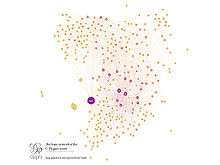Brain simulation
There is ongoing work in the field of brain simulation, including partial and whole simulations of some animals. For example, the brains of the roundworm C. elegans, fruit fly drosophila melanogaster, mouse and rat have all been simulated to various degrees.
C. elegans (roundworm)

The connectivity of the neural circuit for touch sensitivity of the simple C. elegans nematode (roundworm) was mapped in 1985,[1] and partly simulated in 1993.[2] Several software simulation models of the complete neural and muscular system, and to some extent the worm's physical environment, have been presented since 2004, and are in some cases available for downloading.[3] However, we still lack understanding of how the neurons and the connections between them generate the surprisingly complex range of behaviors that are observed in this relatively simple organism.[4][5]
Drosophila neural system
The brain belonging to the fruit fly Drosophila is also thoroughly studied, and a simplified model simulated.[6]
Mouse brain mapping and simulation
Between 1995 and 2005, Henry Markram mapped the types of neurons and their connections in such a column.
The Blue Brain project, completed in December 2006,[7] aimed at the simulation of a rat neocortical column, which can be considered the smallest functional unit of the neocortex (the part of the brain thought to be responsible for higher functions such as conscious thought), containing 10,000 neurons (and 108synapses). In November 2007,[8] the project reported the end of the first phase, delivering a data-driven process for creating, validating, and researching the neocortical column.
An artificial neural network described as being "as big and as complex as half of a mouse brain" was run on an IBM blue gene supercomputer by a University of Nevada research team in 2007. A simulated time of one second took ten seconds of computer time. The researchers said they had seen "biologically consistent" nerve impulses flowed through the virtual cortex. However, the simulation lacked the structures seen in real mice brains, and they intend to improve the accuracy of the neuron model.[9]
Blue Brain and the rat
Blue Brain is a project, launched in May 2005 by IBM and the Swiss Federal Institute of Technology in Lausanne, with the aim to create a computer simulation of a mammalian cortical column, down to the molecular level.[10] The project uses a supercomputer based on IBM's Blue Gene design to simulate the electrical behavior of neurons based upon their synaptic connectivity and complement of intrinsic membrane currents. The initial goal of the project, completed in December 2006,[11] was the simulation of a rat neocortical column, which can be considered the smallest functional unit of the neocortex (the part of the brain thought to be responsible for higher functions such as conscious thought), containing 10,000 neurons (and 108 synapses). Between 1995 and 2005, Henry Markram mapped the types of neurons and their connections in such a column. In November 2007,[12] the project reported the end of the first phase, delivering a data-driven process for creating, validating, and researching the neocortical column. The project seeks to eventually reveal aspects of human cognition and various psychiatric disorders caused by malfunctioning neurons, such as autism, and to understand how pharmacological agents affect network behavior.
References
- ↑ Chalfie M; Sulston JE; White JG; Southgate E; Thomson JN; et al. (April 1985). "The neural circuit for touch sensitivity in Caenorhabditis elegans". The Journal of Neuroscience. 5 (4): 956–64. PMID 3981252.
- ↑ Niebur E; Erdös P (November 1993). "Theory of the locomotion of nematodes: control of the somatic motor neurons by interneurons". Mathematical Biosciences. 118 (1): 51–82. doi:10.1016/0025-5564(93)90033-7. PMID 8260760.
- ↑ Bryden, J.; Cohen, N. (2004). Schaal, S.; Ijspeert, A.; Billard, A.; Vijayakumar, S.; et al., eds. A simulation model of the locomotion controllers for the nematodode Caenorhabditis elegans. From Animals to Animats 8: Proceedings of the eighth international conference on the Simulation of Adaptive Behaviour. pp. 183–92.
- ↑ Mark Wakabayashi Archived May 12, 2013, at the Wayback Machine., with links to MuCoW simulation software, a demo video and the doctoral thesis COMPUTATIONAL PLAUSIBILITY OF STRETCH RECEPTORS AS THE BASIS FOR MOTOR CONTROL IN C. elegans, 2006.
- ↑ Mailler, R.; Avery, J.; Graves, J.; Willy, N. (7–13 March 2010). "A Biologically Accurate 3D Model of the Locomotion of Caenorhabditis Elegans". 2010 International Conference on Biosciences (PDF). pp. 84–90. doi:10.1109/BioSciencesWorld.2010.18. ISBN 978-1-4244-5929-2.
- ↑ Arena, P.; Patane, L.; Termini, P.S.; An insect brain computational model inspired by Drosophila melanogaster: Simulation results, The 2010 International Joint Conference on Neural Networks (IJCNN).
- ↑ "Project Milestones". Blue Brain. Retrieved 2008-08-11.
- ↑ "News and Media information". Blue Brain. Retrieved 2008-08-11.
- ↑ "Mouse brain simulated on computer". BBC News. 27 April 2007.
- ↑ Herper, Matthew (June 6, 2005). "IBM Aims To Simulate A Brain". Forbes. Retrieved 2006-05-19.
- ↑ "Project Milestones". Blue Brain. Retrieved 2008-08-11.
- ↑ "News and Media information". Blue Brain. Retrieved 2008-08-11.